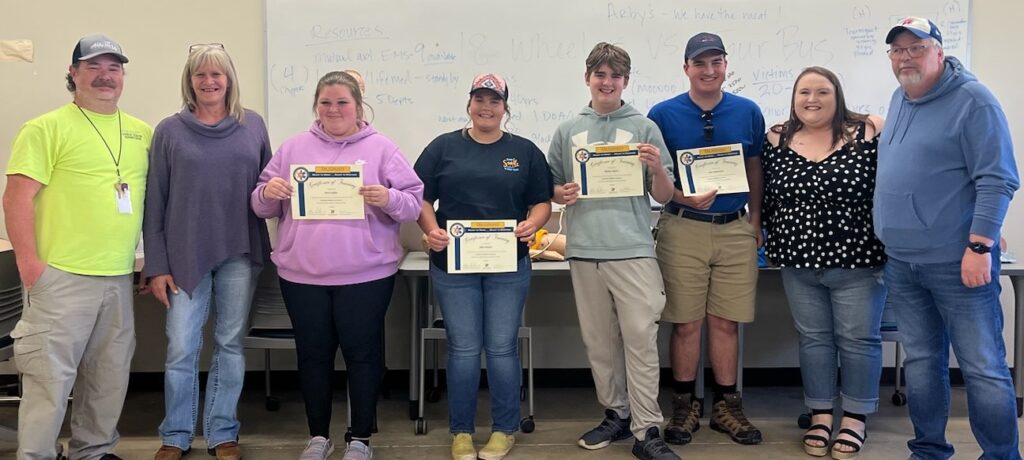
From L – Ben English, instructor; Kim Fairlie, lead instructor; Kera Guffey, DHT trainee/Clay County; Abbi Sawyer, DHT trainee/Graham County; Wesley Myers, DHT trainee/Clay County; Tyler Robertson, DHT trainee/Cherokee County; Gerri Mitchell; and Jeff Ledford, Fellowship Coordinator.
June 30, 2023
Clay County has received a $50,000 investment grant from Nantahala Health Foundation to fund a coordinator for its Emergency Management Technician Training Fellowship.
Grant investment funds from Nantahala Health Foundation are being used to fund a part-time Fellowship Coordinator for two years to mentor students being trained through the Paramedic/Peer Support Specialist Program.
As the newly hired coordinator, Jeff Ledford, a registered nurse and paramedic training officer with more than 30 years of experience, works with high school guidance counselors and others to identify students who are interested in becoming EMTs or paramedics. Ledford’s role includes encouraging students to take the classes that are available to them at the high school level, such as anatomy and physiology and CPR certification. Ledford also mentors and guides students through the courses they need to take at the community college level and works with them to ensure that they are completing their coursework and proceeding through the training at the necessary pace to stay on target for completion.
“Nantahala Health Foundation’s grant investment is essential in our effort to increase the number of students entering the EMT field, which will increase the potential for future available employees,” said Clay County Manager Debbie Mauney. “By ensuring students are successfully recruited and complete all educational requirements for becoming an EMT, we are safeguarding our community.
“These first responders play a critical role in the health and well-being of our citizens and, unfortunately, there has been a decline in the number of people entering the field. The success of this program will be far-reaching and will have an impact on our neighboring counties and the region as a whole,” Mauney said.
Clarissa Rogers, Interim Health Director, remarked that program success has already been realized.
“We had four students successfully complete the training so far. One student has plans to go into the Air Force, two wish to continue to the next level and get the advanced EMT certification, and the final is undecided at this moment,” Rogers said. “The potential to recruit, train and retain our own homegrown students to serve in an EMT capacity is great and much needed in our community.”
About Social Drivers of Health
Social determinants (or drivers) of health, coupled with lifestyle choices based on their availability and ease of access, directly impact more than 80 percent of an individual’s health outcomes, leaving only about 20 percent resulting from clinical care. Long-term research finds are undeniable: Social drivers of health and actively taking advantage of beneficial lifestyle choices when they are available and accessible far exceed cumulative physician visits when it comes to predicting an individual’s health outcomes.
According to the U.S. Department of Health and Human Services’ Healthy People 2030 report, social drivers of health for individuals can be grouped into five categories:
- economic stability
- education access and quality
- health care access and quality
- neighborhoods and built environments
- social and community context
All too often, however, these health drivers contribute to disparities and inequities within some communities. For example, people who do not have access to grocery stores with healthy foods are less likely to have good nutrition. This lack of access raises their risk of life-threatening health conditions like heart disease, diabetes, and obesity — and even lowers their life expectancy relative to people who do have access to healthy foods, according to Healthy People 203
